The Computer
This chapter will describe the parts of a computer, and different types of computers in use.
Here are the basic parts of a computer, shown in desktop form:
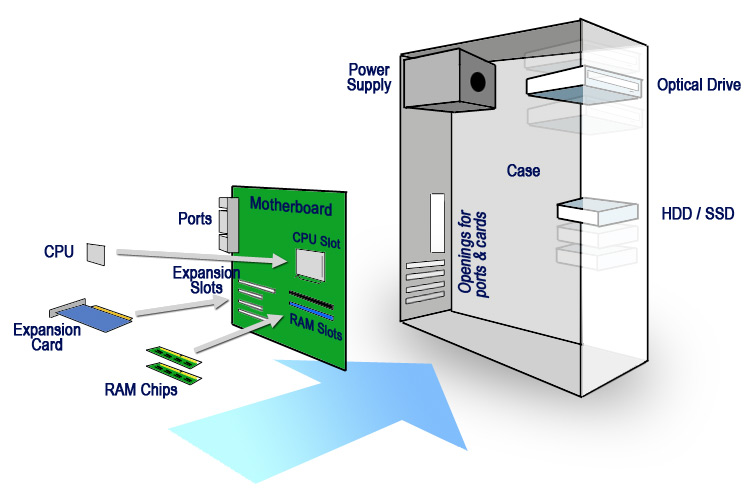
- Case: a shell which contains all computer parts, with openings and frames to install parts. The case usually has at least a power button, but also usually has USB ports, sound ports, cooling fans, and sometimes other devices built-in.
- Motherboard: the foundation for all electronic parts of the computer. It is a fiberglass sheet with electronic circuits on both sides. The CPU, RAM, chipset, cable ports, and other components are attached directly to the motherboard, and all other parts of the computer are attached by cables.
- Ports: on the back edge of the motherboard, there are built in a number of sockets where cables can connect. These usually include USB ports, a network (Ethernet) port, one or more video ports, audio ports, and possibly other special ports. The number and type of ports is different from motherboard to motherboard. Peripherals connect to the computer using these ports.
- CPU: the "brain" of the computer; where the primary commands for programs are carried out. The CPU is either attached to the motherboard, or else fits into a socket attached to the motherboard.
- RAM Chips: RAM (Random Access Memory) plugs into sockets on the motherboard, and serves as a high-speed container for the working data going to and coming from the CPU.
- Expansion Cards: Motherboards usually have special slots to take smaller boards which contain the electronics for special functions. These expansion cards are usually in the form of Graphic acceleration cards, but can also be used to add extra ports, or extra functionality, such as WiFi.
- HDD, SSD: Hard Disk Drives and Solid State Drives function as the main storage devices for a computer. On a desktop computer, they are usually located behind the front panel, and connect to the motherboard using a special internal cable called SATA.
- Optical Drive: CD, DVD, and Blu-Ray drives allow computers to access these types of media. They are located behind the front panel of the computer, with an opening which allows discs to be inserted. These are slowly disappearing from computers; few laptops have optical drives today.
- Power Supply: usually located at the back of the case, the power supply is a box-like device which has a power cable port on the side sticking out of the back of the case, and many rainbow-colored cables within the case which connect and provide power to the various parts of the computer.

The Case
Sometimes called the "CPU box," the computer case (also called the "chassis") acts both as a platform to attach all internal hardware, and as a protective cover for the computer's parts.
Usually, one or both sides of a case is capable of opening or being removed. Inside, there is space to install all the internal parts of the computer.
The motherboard is installed on top of small posts, mountings for screws; when the motherboard is placed, one side of the motherboard lines up with the back of the case. One half of that side is for cable ports; the case has a rectangular opening for this. The other half consists of several think openings. This is for expansion cards.
When an expansion card is installed on a motherboard, one end of the expansion card my stick out enough to fit perfectly into these thin slots. This is done if the expansion card has ports for external cables.
If a case has space for optical drives, this is often at the top front of the case. These spaces are called bays. Optical drive bays must have openings in the front of the case to allow discs to be inserted. Bays for hard drives are usually at the middle or bottom front.
The power supply is mounted at the back, usually at the top or bottom of the case.
Buttons and cable ports on the case have wires which lead inside and must be connected to the motherboard.
Pictured above is a "DIY" case for people who wish to assemble their own computers. DIY cases are usually larger "tower" cases with much room for adding extra components; there are few compact DYI cases, and few or no DIY options for laptop or other mobile devices. Cases for pre-assembled desktop computers are usually designed to be very compact, with parts made to fit the case exactly. This is much more true to laptop and other mobile devices.
The Motherboard

A motherboard is the foundation of the computer, the one part which is directly connected to all other parts. It is packed with components, filling up the small space available. The center of the motherboard is the CPU Socket, where a CPU can be installed.
Another key component are the RAM slots. They usually come in pairs; 2, 4, or 6 are common numbers. Each slot accepts one RAM chip; the chip can be of various capacities, normally no more than 16GB each.
A chipset typically routes all data between the CPU and the rest of the computer. Older computers needed special expansion cards for features such as sound or Ethernet, but these have become integrated into chipsets. Newer CPUs connect directly to RAM and graphics cards, with the chipset still connecting the CPU to other data inputs (storage drives, cable ports, etc.). Chipsets also determine things such as how much you can expand the hardware on your computer, how many USB ports your computer can support, or whether or not you can overclock your CPU (make it run at higher speeds than normal). Chipsets are built into the motherboard, and are not replaceable like CPUs and RAM chips are.
Again, note that the cable ports stick out of one half of one side of the motherboard. Computer cases have a rectangular opening for these, so they stick out of the back of the case. When you see this collection of ports, understand that it represents one side of the motherboard.
Similarly, expansion cards often reach outside the case as well, next to the ports. Look at the back of the computers behind you in the lab; you will see several thin rectangle shapes beside the ports. These metal sheets can be removed to reveal expansion card ports. Our new computers have such a card—a video card—with video ports visible on the back of the case.

The CPU
A modern CPU can have hundreds of millions, or even billions of transistors (a transistor in a CPU is basically an on/off switch), arranged in a complex design.
CPUs carry out the instructions in a computer program (often with assistance from separate graphics chips). They have small amounts of memory—usually only a few megabytes—to help increase processing speed, but the chip is too small to allow much more memory on the actual chip.
Most CPUs are inserted into sockets on the motherboard. The CPU pictured here has gold-colors connectors, which touch tiny pins in the motherboard's CPU socket. In past CPUs, the pins were on the CPU, and the connectors were in the CPU socket.
Most personal computers use Intel CPUs, although AMD CPUs are also very popular.
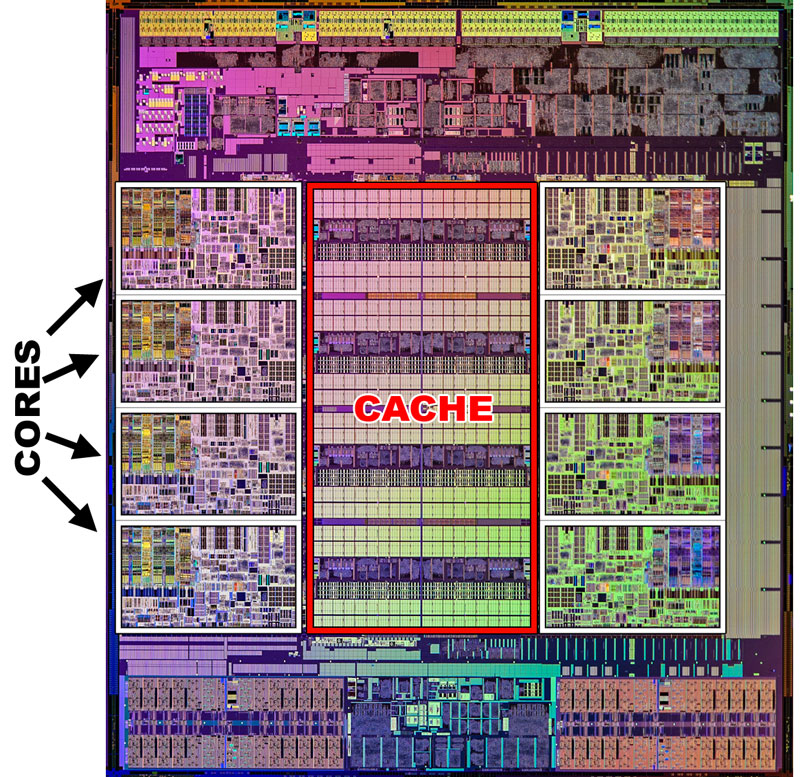
CPU Elements
The CPU has two main parts: cores and cache.
Each core processes data. It's a little bit like a person working at a job. Add another person, and the job gets done faster—or two different jobs can be done at the same time. Cores work in a similar way: the more cores a CPU has, the more work it can do at once.
The cache is local data keeping. It is memory, like RAM, but it is located on the CPU itself, very close to the cores. The cache keeps data and instructions close to the cores so the cores will always have a supply to work on. Without cache, the cores must wait for data and instructions to be delivered from the RAM, which sometimes takes too long. If the cores are waiting without data, the computer does no work, and it slows down. Cache solves that problem.
Imagine that four people are working on a job, packing products into boxes. They can work fast—but only if they have supplies nearby. They need a supply of the products, boxes, and tape to seal the boxes. If they run out of supplies, they have to wait for more supplies to arrive. While they wait, they can do no work. If they have a cache of supplies which is always full, they never have to wait, and they can do more work in a shorter time. This is true of computer cores and cache; more cache means the cores can work at full speed, and no time is wasted.
So, more cores and more cache mean a faster CPU. However, it's not a simple equation: two cores does not mean 200% more speed than one core. Doubling the cores may lead to something like a 60% or 70% increase in speed. It is similar with cache; doubling the cache does not double the CPU speed.
Other features can add speed. CPU threads are virtual "cores" which can double the apparent number of cores in a CPU. On Intel chips, this is called "Hyperthreading," and on AMD chips, "Multithreading."
There are many features in a CPU which affect speed. For example, the size of a CPU chip is also important. If the size of the circuits and transistors in a CPU can be made smaller (this is what tech people mean when they talk about a smaller "die" and "nanometer processes"), then the CPU itself can be smaller. This increases speed (the data doesn't have to move as far), reduces cost (more chips can be made for the same price), and improves battery life (smaller chips often use less electricity).
Something people talk about a lot is clock speed. This is measured in Hertz (cycles); each cycle means data and instructions move a number of steps forward inside the chip. The "clock" is like timing for music: the faster the tempo, the faster the music. the faster the clock speed, the faster data moves inside the CPU. However, moving faster does not always mean that the CPU is working efficiently. Some times, when you speed up, it slows down your ability to do things. Clock speed is rarely a good indicator of speed unless you are comparing two very similar CPUs.
How to Measure CPU Speed?
In the end, the best way to measure the speed of a CPU is with benchmarks. A benchmark is a set of specific tests which measure a CPU's ability to perform common tasks. Passmark has an extensive listing of CPU benchmark scores, allowing you to compare the CPUs of different computers.
For example, my wife needed to buy a new computer—her 5-year-old Macbook Pro laptop was getting to be too slow. A new Macbook and Macbook Air came out soon before then, and looked like good computers. However, when I checked Passmark, my wife's old computer had a CPU score of 3305. The new Macbooks had CPU scores of 3266 and 3598. Even the best Macbook Air scored at 4203—only about a 20% increase in speed over a 5-year old computer! In comparison, my new Macbook Pro had a score of 9347!
We decided to wait until a new set of Macbook Pros came out, so that the lower-priced models would probably have a score twice as high as the recent Macbook Airs. Even though the Macbook Air works okay when you buy it, I know that my wife uses one computer for five or six years, and the Macbook Air would not be fast enough to last that long.
How did I find all this out? I checked the benchmark scores!
CPU Generations
The most common CPUs are made by Intel, and for some times have been using a dedicated naming system to generally help understand which models are better than others. This includes information on chip family, generation, and model number.
Intel Families
| Family | Cost (Aug. 2021) | Uses / Cores / Benchmark Score |
|---|---|---|
| Core i3 | ¥10,000 ~ ¥20,000 | Cheap; 4 cores; for everyday tasks; score up to 10,127 |
| Core i5 | ¥16,000 ~ ¥35,000 | For medium-power apps; 6 cores; score up to 20,088 |
| Core i7 | ¥35,000 ~ ¥47,000 | For high-power consumer tasks; 8 cores; score up to 25,102 |
| Core i9 | ¥44,000 ~ ¥115,000 | Best consumer performance; 8+ cores; score up to 33,856 |
| Xeon | Wide range (up to about ¥1,000,000) | For servers/workstations; up to 24 cores; score up to 41,412) |
AMD CPUs have a similar lineup with similar prices and features:
AMD Families
| Family | Cost (Aug. 2021) | Uses / Cores / Benchmark Score |
|---|---|---|
| Ryzen 3 | ¥17,000 ~ ¥19,000 | Cheap; 4 cores; for everyday tasks; score up to 12,757 |
| Ryzen 5 | 35,000 ~ 40,000 | For medium-power apps; 6 cores; score up to 22,158 |
| Ryzen 7 | ¥50,000 ~ ¥52,000 | For high-power consumer tasks; 8 cores; score up to 28,495 |
| Ryzen 9 | ¥69,000 ~ ¥94,000 | Best consumer performance; 12-16 cores; score up to 46,130 |
| Ryzen Threadripper | Wide range (¥170,000 ~ ¥528,000) | For servers/workstations; up to 64 cores; score up to 81,075) |
As you can see, some AMD CPUs are pricier, but they give better performance, especially at the high end.
New generations are issued every year or two. Intel's are easier to follow; their model numbers show the generation by the thousand-count for the model number. For example, as of 2021, Intel has introduced their latest 11th-generation models, with model numbers in the 11,000 range (for example, the Core i7-11700). Models from the previous generation are in the 10,000 range (for example, the Core i7-10700), and so on.
A higher generation is usually better, and higher model numbers tend to be better as well.

CPU Sockets (Slots)
Every motherboard has a CPU socket. This socket cannot be changed on the motherboard. The socket is made for certain generations of CPUs.
Each socket type has a certain number of contact pins in a certain configuration. A CPU made for one socket cannot be used in a different socket.
The most recent Intel socket is the LGA1200, which has 1200 pins to connect to CPU contacts. The LGA1200 socket is used for the 10th and 11th-generation CPUs. The previous socket, the LGA1151, had (of course) 1151 pins, and could fit the 6th~9th generation of Intel CPUs.
That means that if you have a DYI computer with a 6th-generation CPU, you could replace it with up to a 9th-generation CPU—but not a 10th or 11th.
RAM Memory

RAM is also called memory. It is a high-speed data holding device.
Data is permanently kept in storage, usually hard disk drives (HDD) and solid state drives (SSD), but these storage devices are much too slow to provide a constant stream of data for the CPU. The CPU is too small to keep the large amounts of data (in its cache) which it needs to process.
RAM, therefore, serves as a middle holding place for data. It is slower to send data to and from RAM than it is to keep it on the CPU in cache, but is much faster than storage drives.
RAM is volatile, meaning that data is lost when power is turned off. This is why you often lose your typing when your computer crashes and you have to restart.
Typical RAM capacities are 2MB, 4MB, and 8MB chips. A current computer should have at least 8GB of RAM, though 16GB would be better for a computer you plan to use for several years.
RAM comes in different types; the current type is called DDR4 (Double Data Rate 4). DDR4 RAM can be used on motherboards made over the past 6 or so years (LGA1200 CPUs can work with DDR4, and most LGA1151 CPUs, but not previus socket designs).
DDR5 RAM is scheduled to be released on personal computers by the end of 2021.
| Type | Speed | Released |
|---|---|---|
| DDR | 3.2 GB/s | 1998 |
| DDR2 | 6.4 GB/s | 2003 |
| DDR3 | 12.8 GB/s | 2007 |
| DDR4 | 25.6 GB/s | 2014 |
| DDR5 | 51.2 GB/s | 2021 |
Expansion Cards

Expansion cards are hardware add-ons within the main computer case. They plug directly into sockets on the motherboard, and add extended functionality to the computer.
In the past, expansion cards were often used for sound and network functions, but these are typically included in most motherboards now, and so are rarely used today.
The most popular use of expansion cards are video / graphics cards, containing powerful GPUs (graphics processing units), which allow for high-quality graphics in gaming and other computers. Such a graphics card is shown in the illustration above.
Other uses for expansion cards is usually limited to professionals, who need special hardware not available on typical computers.

HDD and SSD
Storage refers to long-term keeping of data on non-volatile devices—devices that can keep their data even when power is turned off.
Hard Disk Drives (HDD) have been the traditional storage type for more than 30 years, but HDDs tend to be large, noisy, slow, and inconvenient.
A new type of storage is replacing them: the Solid State Drive (SSD), which is a type of flash memory. SSDs are smaller, lighter, use less energy, and can be shaped to fit even the slimmest computers. More importantly, the Solid State Drive is considerably faster than HDDs. A computer with an SSD can start up twice as fast as a computer with only a hard drive.
However, SSDs are also more expensive, with less storage capacity. A 2TB (2000GB) HDD costs as low as ¥6000; the cheapest 2TB SSD costs about ¥20,000, more than 3x the price for the same storage. Using an SSD will definitely cost more, and/or give you less storage space. However, the benefit of speed, size, and shape make the SSD valuable enough that people spend the extra money to get one.

Optical Drives
Optical Drives include drives for CDs, DVDs, and Blu-ray.
Optical drives for desktop computers tend to be large and bulky, though slimmer versions exist.
However, these drives are slow to read data, and saving data to an optical disc can be complicated and time-consuming. Even though they are a very cheap, reliable, and long-lasting form of data storage, fewer and fewer people use them.
Optical drives are quickly disappearing as Flash memory and Internet Cloud storage have become more and more popular. Online music and video services are replacing music and movies on optical discs. Most computers don't even have an optical drive today, but you can buy peripheral (external) optical drives which connect using USB. So don't worry—you can still play your old collection of movie DVDs.
However, there is one more warning: movie discs have region codes, meaning that they only work in the part of the world where they are sold. DVD movies, for example, have six regions; Japan and the United States are in different regions, so a DVD from one country will not play in a drive from the other country. Blu-rays, however, have only three regions world-wide—and Japan & the U.S. are in the same region.
Optical drives for computers can change regions; if you put a disc from a different region in your drive, it will ask if you want to switch regions. However, this can only be done five times, and then the region will be locked permanently.

Power Supply
A Power Supply Unit (PSU) takes electricity from a power outlet ("AC") and converts it into a type of electricity that computer parts can use ("DC"). The PSU has several cables which are designed to fit motherboards, storage devices, graphics cards, and case fans; the different cables deliver electricity to different parts of the computer inside the case.
Some PSUs can deliver more power than others, which may be necessary for computers with extra hardware (such as graphics expansion cards) that use a lot of energy.
Laptop computers usually have a PSU as part of their power cable—the boxy "brick" in the middle of the cable. Smaller devices like tablets and phones charge using USB cables (using DC power), either getting the DC current directly from a computer, or from a USB power adapter.
Remember, not everything with computer chips in it is a computer. It needs to be able to run programs, accept input, store data, and deliver output. Still, this includes a wide range of devices, most of which are listed below.
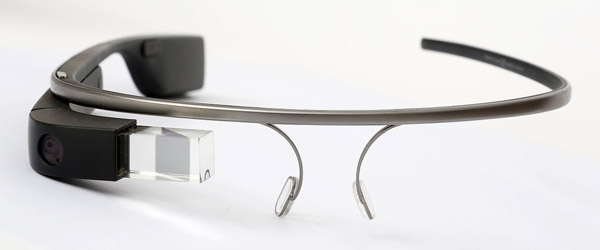
Wearables
A new category of computer devices are wearables: computers (or computer-related devices) that can be worn. Google has been at the forefront of computerized glasses, and many companies have released "smartwatches." Though wristwatches with more and more advanced computer functions have been around for a while, smartwatches have become popular in the past few years mainly due to the expectations of the Apple Watch.

As devices become smaller, they also become more personal. The tablet is more like a book than a computer, and is used for consuming content (books and videos); the smartphone is a personal data device, used not just for telephony, but also for photography and social media.
The smartwatch is even more personal. In addition to telling time, it is most often used for social interaction (texts and other messaging), scheduling (appointments and contacts), and—perhaps most significantly—personal health. Smartwatches are currently outfitted often with heart rate monitors, and in the future, it is expected that other health monitors will be added.
"Smart glasses," as they may be called, provide personal data services, including scheduling, communications, weather, mapping information, and more. Google's original Glass project failed, interestingly, because it was too personal: people reacted negatively to the loss of privacy, as the glasses' cameras could be recording anything at any time. Google is now working on an improved version.
One characteristic of wearables is that they are not independent; they require other devices, connected through wireless networks, to do much of the work. While miniature portable CPUs are getting more and more powerful, these devices are too small to do much work by themselves. For example, in order to use the Apple Watch, an iPhone is required.

Smartphone
Many mobile phones are smartphones; essentially, "computers that make phone calls." They have the same computer power that desktop computers had less than ten years ago. They use an Operating System and applications, just like any computer.
Smartphones are a combination of several previous devices. In the past, people had one machine to play music (a "walkman" or other digital audio player), another for address book, calendar, and notes (a "PDA"), another for taking images (digital camera), another for taking videos (video camera), and another still for a cell phone. Some people also carried portable game consoles, had GPS devices in their cars--and most people wore wristwatches. The smartphone combined all of these into one device, and added much more with thousands of easily downloadable computer programs. Instead of carrying six or eight devices, we now can carry just one—and we can do much more with it!

Tablet
A tablet is a flat computer which consists of a display with computer parts built into the slender body behind the display. Tablets have no physical keyboard (though a keyboard can be attached), relying instead on touch or stylus input. Current tablets use "multi-touch" input, a touchscreen technology that allows for more than one point of input. In contrast, a traditional computer only allows one on-screen point of input—the cursor.

Hybrid Tablets
A hybrid tablet is a computer in tablet form that can function either as a tablet, or as a normal PC. Microsoft's Surface computers are typical of this type.
Hybrids will have a thin design, a touchscreen, a low-power mobile CPU, and a detachable or separate keyboard. It likely runs a desktop operating system, such as Windows.
Apple Computer initially dismissed Microsoft's Surface hybrid as a "refrigerator-toaster," suggesting that a combination of laptop and tablet did not make sense as the two devices served very different purposes. However, the Surface computer has been quite successful.
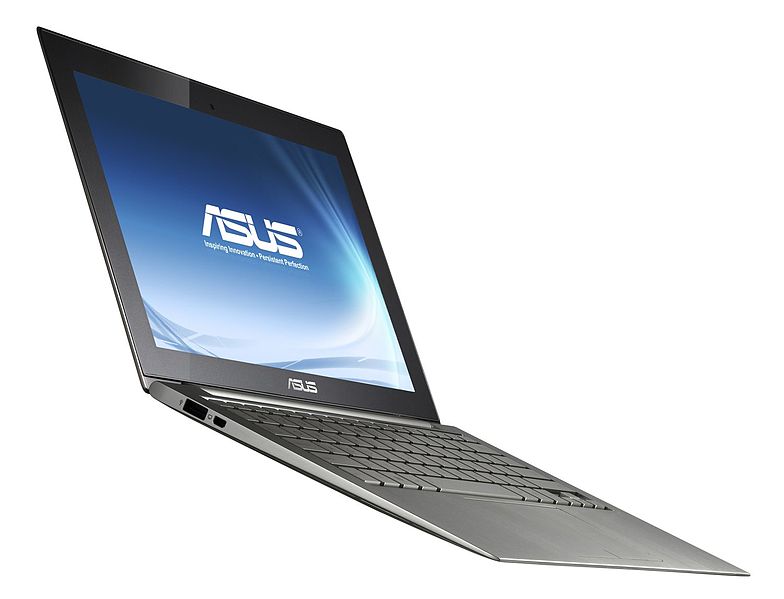
Ultrabook
Ultrabooks might be called sub-notebooks, as it refers to general portable computers which are notably smaller than normal laptops.
In 2007, a new type of portable computer was developed, called the netbook. This was a class of laptops which had monitors less than 13" in size. Many people bought these believing they would perform as well as most laptops; they were disappointed, as netbooks proved too weak to do the tasks most computers could handle. Netbooks lacked optical drives, not because they were not needed, but because there was no space for them.
From 2008, Apple began making the Macbook Air, an ultra-thin laptop with a 13" screen size; however, the high price kept the model from becoming popular. In late 2010, the SSD (solid state drive) became standard, an 11" model was introduced, and the price was deeply cut (from $1800 to $1000); the Macbook Air became widely popular.
The Macbook Air was noted for the very slim but sturdy metal body, in particular the wedge shape in which the front end of the computer appears almost as a "blade." Although the computer had the same lacks as netbooks, such as no optical drive, these were compensated for by dependence on wireless networks. Also, the computer was powerful enough to do the tasks most users required.
In 2011, after the Macbook Air was an established success, Windows computer makers followed with very similar computers, given the name Ultrabooks by Intel.

Laptop (Notebook)
A laptop, or notebook computer, also called a portable computer is essentially a computer which runs on batteries. Screen sizes usually range from 13 to 17 inches. Laptops are less powerful than desktops, but cost a lot more.
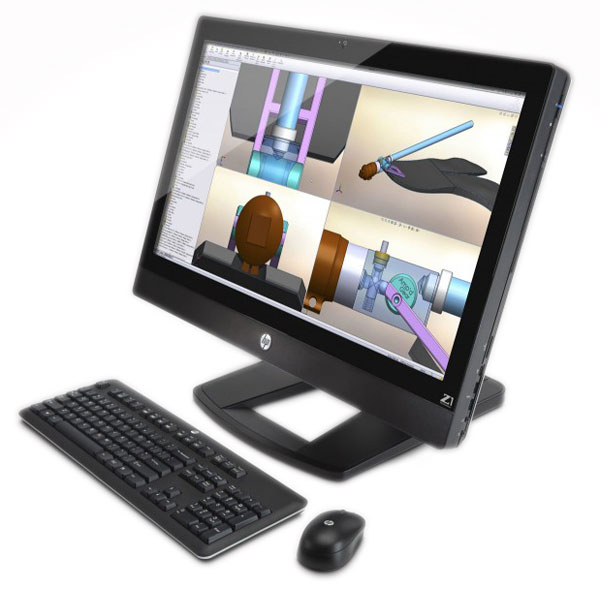
All-in-One ("AIO") Desktops
All-in-One computers are Desktop computers which have all of the hardware (except for the keyboard and mouse) fit into the monitor frame.

Desktop
Desktop computers are not portable at all. They are heavy and require several cables. They are the cheapest type of computer and can be powerful, with strong CPUs, a lot of memory and storage, and special additions such as video cards. If you do not need to move your computer around and need the most power for the lowest price, this is the one to get.

Workstation
Workstations are the highest-power desktop computers available to the general public. Typically, a workstation has two or more CPUs, the CPUs being a powerful type not found in most personal computers; it has more RAM than personal computers; it often has many large storage drives, sometimes linked together for greater speed and/or capacity; and it has many other hardware features or add-ons required by the particular user.
Workstations are very expensive, and are usually used professionally by people who require very powerful computers (e.g., computer animation or CAD / Computer Assisted Design).
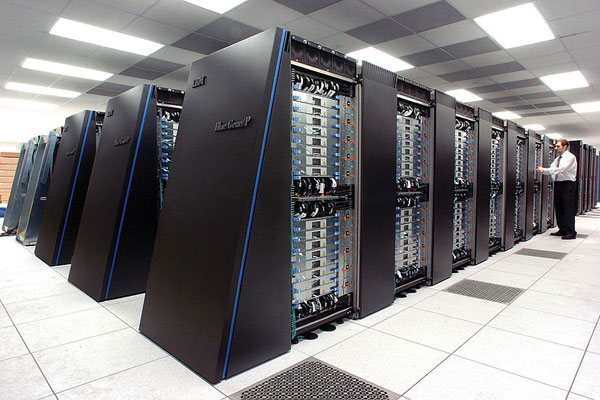
Supercomputer
A supercomputer is a large-scale computer, usually with a large number of CPUs, which is amongst the most powerful computers in the world. Supercomputers are used for massively complex problems, from weather forecasting to code breaking to physics problems.